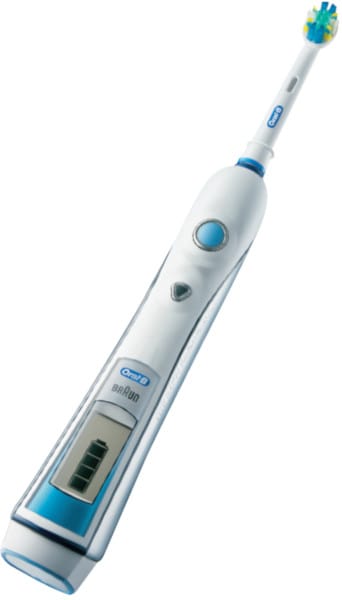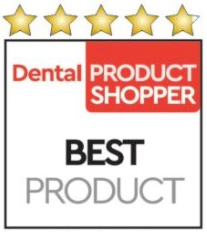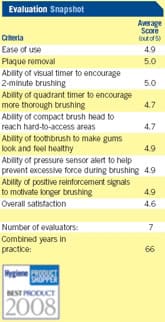The Smart Way to Promote Brushing Compliance The Oral-B Triumph with SmartGuide is available to dental professionals for trial and dispensing.
Oral-B Triumph with SmartGuide uses visual encouragement to promote better at-home brushing
The impetus behind the development of Triumph with SmartGuide is research that shows most patients brush less than the recommended 2 minutes twice a day. According to the manufacturer, Triumph with SmartGuide is the first rechargeable toothbrush with a wireless remote that visually indicates brushing time, brushing mode, and pressure.
For this product review, 7 hygienists were asked to use Triumph with SmartGuide for 4 weeks and then tell us what they think.
Plaque Removal
Based on research conducted by Procter & Gamble, Triumph with SmartGuide provides 19% more plaque control compared to brushing with a manual toothbrush.
When the hygienist evaluators were asked to rate the toothbrush on plaque removal, all 7 rated it as excellent, giving it a perfect score. One hygienist commented that her teeth felt “squeaky clean.” Another said that she “loved the just-from-the-dentist feeling.” A third evaluator said her teeth “feel cleaner than manual brushing.”
Brushing Encouragement
Based on research conducted by the manufacturer, patients who brush with Triumph with SmartGuide increase their brushing time by 38%. The manufacturer also claims that compared with brushing with a manual toothbrush, patients are 5 times more likely to brush for 2 minutes.
The hygienists who evaluated this product were asked to rate the ability of the visual timer to encourage 2-minute brushing. All 7 evaluators rated this feature as excellent. One evaluator said “Love it! A definite motivator to continue brushing to the 2 minute time.” She also noted that there is “no need to stand in front of the timer to register [the] time brushed.” Another evaluator said, “I loved the separate timer. The ones on the handle of the brush are hard to see while brushing. This was awesome.” A third evaluator commented that she feels “patients will brush for the recommended time seeing a visual timer.”
Pressure Sensor
The SmartGuide feature of the Oral- B Triumph power toothbrush includes a pressure sensor alert. When the hygienist evaluators were asked to rate the ability of the pressure sensor to help prevent excessive brushing force, 6 rated it as excellent and 1 rated it as very good.
One evaluator said, “The sensor is a great feature. I see many patients who use power brushes and damage gingival tissue.” Another noted that “until you see the warning light, you have no idea the amount of pressure you are using. [This is] a great guide for those [who] brush too hard.” One evaluator said, “I found some sensitivity to buccal areas even with the pressure sensor. Maybe need to make it a bit more sensitive.”
Healthy Gums
According to recent research, Triumph with SmartGuide has been proven to help prevent gingivitis in healthy patients.1 Manufacturer research shows 32% lower gingival bleeding scores at 6 months vs baseline. The evaluators were asked to rate Triumph with SmartGuide with regard to its ability to make gums look and feel healthy. Six evaluators rated it as excellent and 1 rated it as very good. One evaluator said that her “gums were well stimulated. Even more so than with other power toothbrushes.” Another evaluator commented that “bleeding was definitely decreased, resulting in firmer gingiva.”
Overall Satisfaction
When asked if they would recommend Triumph with SmartGuide to colleagues, all 7 evaluators said definitely. They all also said they would definitely or probably purchase it in the future. Finally, when asked to rate their overall satisfaction with the product, the 4 evaluators rated it as excellent and 3 rated it as very good. One evaluator said that she found the brush “very easy to use. I like the clock…the guide with the timer, and the information on the pressure used.”
Reference
1. van der Weijden GA, Rosema NAM, Versteeg PA, et al. Different modes of oral hygiene to prevent plaque and gingivitis. J Dent Res. 2006;85(special issue B). Abstract 2266.






